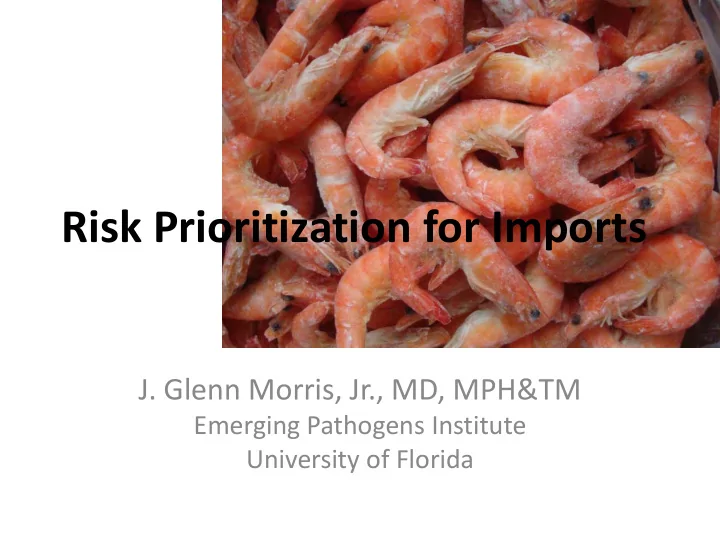

Risk Prioritization for Imports J. Glenn Morris, Jr., MD, MPH&TM Emerging Pathogens Institute University of Florida
Approaches to Control of Foodborne Illness • Risk-based • Data intensive • Strategic data collection • Improved access to data • Modern Information Technology • Increased analytic capacity
Step 1: Strategic Planning Identify Public Health Objectives Step 2: Step 6: Establish a Risk Management Plan Public Health Risk Ranking Monitoring and Review Establish Metrics to Measure Performance Collect and Analyze Data on Develop or Select Tools for Public Evaluation Measures Health Risk Ranking Interpret Data and Evaluate Rank Risks Based on Public Health Intervention Results Outcomes Determine Whether Public Health Report Results and Solicit Feedback Objectives Are Being Met Communicate Results to Stakeholders Review and Refine the Process as Necessary to Accomplish Intermediate Outcomes and Public Step 3: Health Objectives So As to Achieve Targeted Information Continuous Improvement Gathering and Consideration of Other Factors Identify and Consider Additional Step 4: Criteria for Decision Making Analysis and Selection of Conduct Targeted Information Intervention(s) Gathering Identify Priority Risks for Identify an Appropriate Level of Intervention (Instrument) Analysis Protection for Each High-Priority Risk Step 5: Identify Intervention Options Identify the Type of Technical Analysis Design of an Intervention Plan Needed to Evaluate the Options Gather Information Develop a Plan for Choose Intervention Strategies Implementing the Selected Report Results, Solicit Feedback, and Interventions Modify Intervention Strategies If Allocate Resources and Needed Implement Interventions
Primary Food Safety Problems in the U.S.
WARNING: Risk-Based Food Safety Systems are Data Intensive The risk-based approach requires accurate, reliable, secure, timely, comprehensive data that are: • integrated; and • “fit-for-purpose”
Some Imported Commodities of Particular Interest • Fresh vegetables: – Import share is over 17% by volume, & over 9% by weight - nearly doubled since early 80s – From 2000-2005, spinach & lettuce imports up >300%, onions up 51%, tomatoes 36%, etc – Growth primarily in Mexico and South and Central America • Seafood: – Now about 80% import share by weight – Only one in top 10 consumed seafood products is not primarily imported: catfish – Growth in Asia: China, Thailand, Indonesia, Vietnam, Philippines
Sporadic Cases • Magnitude of problem of import-related foodborne illness unclear: tough enough to attribute sporadic illness to specific foods, much less identify international sources/problems Between 1998-2004, only 19 outbreaks explicitly linked to imports, • 4 to seafood… – (Tauxe RV, O’Brien SJ, and Kirk M. 2008. “Outbreaks of Food-Borne Diseases Related to the International Food Trade” in Doyle and Erickson) Yet outbreak data shows 984 seafood-related outbreaks between • 1990 and 2004… – (Todd E & Caswell JA. 2008. “Role of Programs Designed to Improve the Microbiological Safety of Imported Food.” in Doyle and Erickson) And 80% of seafood is imported… •
Risk-Based Import Food Safety Systems • Proactive, not reactive (strategic planning) • Process: – Identify major public health risks – Identify additional data/information needs to determine allocation of resources (talk to stakeholder communities) – Develop data-driven, analytic framework – Select intervention strategies based on risk and resource availability – Continuously evaluate outcomes
What is Risk-Based Import Safety? • Risk refers to public health, not “risk of violation” – Focused on reducing illnesses and human health risk – Not all violations are the same – many are not directly related to public health (e.g. labeling errors) • Targets resources towards products & shipments most likely to harm Americans • Data driven: Goes beyond the ports to gather information that can inform assessments/evaluations of risk
New Hazards: Emerging Pathogens Appearance of new/ • genetically different strains – “German” E. coli O104:H4 • >3,000 cases • 852 HUS cases as of July 5, 2011; 32 deaths • Genetically: shiga toxin gene from EHEC in EAgEC genetic background • Sprouts likely source; ? fenugreek seeds from a single Egyptian exporter
New Hazards 1. Appearance of new/genetically different strains 2. Changes in opportunities for pathogen growth and spread (often anthropogenic) 3. Intentional contamination/economic adulteration Problem: Single point source of contamination can generate a national/international outbreak Solution: smoothly functioning, timely, accurate data systems
Risk-Based Import Food Safety • Identify the major problems from a public health perspective (i.e., what’s making people sick?), and target interventions accordingly • Get the data – Figure out what you need, and design appropriate, accurate data collection systems – which may or may not include on-site inspection
Recommend
More recommend